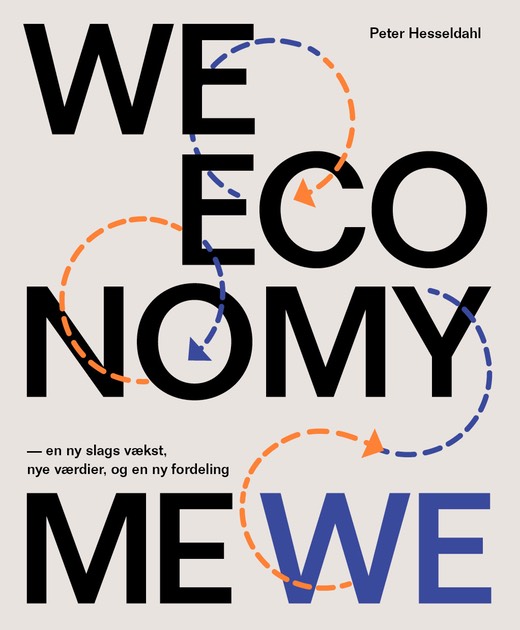An ecology of factories thriving on each other?s waste
In the Danish town of Kalundborg, a number of industrial companies from very different sectors exchange waste and resources with each other in an elaborate network of pipelines. For decades this circular system has provided the participants with cheaper energy and raw materials ? while reducing the costs of disposing waste. Now, the ?symbiosis? model will be used to create similar exchanges in other Danish industrial parks.
In the Danish town of Kalundborg, a number of industrial companies exchange waste and resources with each other in an elaborate network of pipelines. The cooperation is known as ?Kalundborg Symbiosis?.
Among the participants are a refinery, a power plant, an enzyme producer, a producer of insulin, and a manufacturer of gypsum board.
These companies send waste from their production process on to other companies in the system, which can then use this as valuable input for their process. Steam, sludge, fly ash or hot water are some of the resources exchanged.

Kalundborg symbiosis is one of the clearest examples of a circular economy, which minimizes waste and re-uses resources in a system, which in many respects resembles a metabolism ? or an eco-system of very diverse participants.
Extending collaboration across industries and sectors
By looking beyond their own industry, the factories in Kalundborg have created beneficial collaborations with companies and partners that they would conventionally not have any interaction with. Taking a broader perspective has uncovered important resources that would otherwise not be available.
It is precisely the diversity of needs and uses of resources that makes the exchanges valuable. If all stakeholders had the same type of production, they would not be able to use each other?s residuals.
This case is based on interviews with:
Mette Skovbjerg, project manager, Symbiosis Center Kalundborg. http://www.symbiosis.dk/en
Fifty years of exchanges
The project dates back more than fifty years. The first exchanges took place back in 1961, and at the time it was prompted by a lack of access to water.
Since then, the system of exchanges has gradually been extended. Today, it includes 30 different material, water and energy streams between 13 different companies and a range of farms and municipal institutions.

It was not until around1989 that there was much outside awareness that this might be a unique model of collaboration. The model started to be studied by researchers and planners, and since then, visitors from around the world have been coming to Kalundborg to learn from the project.
In recent years, the municipality realized that the symbiosis project has become an important factor in the local economy; to keep the large companies and factories, and to attract new activities and talents to an otherwise somewhat distant part of Denmark.
In 2011 the official Symbiosis Center was established: It focuses on education and courses in creating resource exchange systems, and the center also works pro-actively on identifying potential candidates for new, similar exchange projects in the region.
Industrial symbiosis has now become part of the overall Danish strategy for developing business. The Danish Business Authority supports activities all over Denmark to identify and start potential systems of resource exchange.
Next phase: Adding intermediaries
As the low hanging fruits have been picked and the simplest and largest exchanges have been established, the next level of integration requires more than merely connecting two factories with a pipeline.
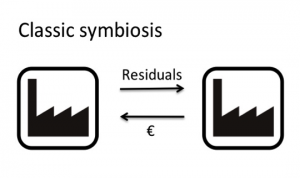
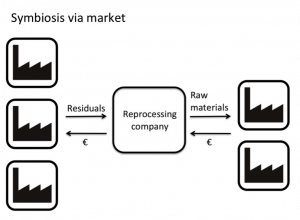
So far most exhange have been direct transfers of energy, materials or water, which could be used immediately without any processing. There are still waste streams, which could be turned into resources for other companies, but to makes these residuals useful takes some re-processing.
This approach is reflected in the recently established algae water cleaning station in Kalundborg, which uses algae in large tanks to clean wastewater and extract useful nutrients for fish feed or biodiesel.
In a sense, the symbiosis is entering a new phase with the addition of intermediate processors. Again, the comparison to an eco-system is obvious: As in nature, smaller organisms find a niche, processing waste and passing it on as food for larger organisms.
http://ing.dk/artikel/algeanlaeg-skal-rense-kalundborg-virksomheders-spildevand-132297
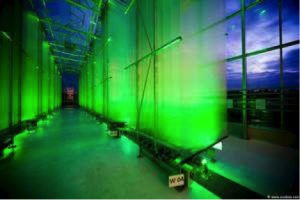
Notably, a very ambitious plan to create a smart electricity grid for the city recently failed, despite quite large scale funding.
Value creation: The busines case
Participants save money in two ways: they have less waste to dispose of, or they receive cheaper energy or raw materials for production.
A loose estimate of the total savings in the system is 600 million DKK pr. year.
Prices of energy and raw materials fluctuate considerably, as do fees for handling waste or regulatory demands for recycling. The recycling system makes companies less volatile towards rising prices.
Keeping the ressource local and short also saves money for transportation. Gyproc, the gypsum wall manufacturer, is one of the oldest participants in Symbiosis. Dong Energy?s powerplant is partly coal-fired, and to remove sulfur from the exhaust, calcium is injected in the boilers. The result is regular gypsum, which is loaded on trucks and delivered to Gyproc, 3 kilometers down the road.
Gyproc pays about the same price for the raw gypsum, as it pays for mined gypsum imported from Spain. However, the freight is much cheaper compared to sailing gypsum on boats from Spain to Kalundborg.
Value creation: Environmental and societal benefits
The local community benefits from the improved competitiveness of its local industry, which secures jobs. Having a world-renowned project in town makes it easier to retain and attract talent.
For society as a whole, the environmental benefits from a more circular approach to manufacturing are obvious. As these examples show, the quantities involved are large:
- Yearly CO2 emission reduced by 240.000 tons.
- 3 million m3 of water saved through recycling and reuse.
- 30.000 tons of straw converted to 5,4 million liters of ethanol.
- 150.000 tons of gypsum from desulphurization of flue gas replaced imported natural gypsum.
Motivation: It has to make sense economically
Participants in the project are primarily motivated by the economic benefits. Investments in establishing exchanges (for instance building pipelines) are subject to conventional demand for a reasonably short ROI ? typically within three years.
There is also an element of idealism in terms of reducing impact on the environment or strengthening the local community.
Fundamentally, however, the Symbiosis particpants are not companies that see themselves as particularly green.
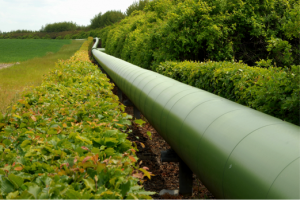
A pipeline carrying steam to Novo Nordisk?s insulin factory from DONG energy?s power plant
When consultants from the Symbiosis Center approach companies to make them build new exchanges, they will deliberately not use the sustainability and circular economy rhetoric ? they know that this is not what determines if a company chooses to participate.
For the municipality the symbiosis project is seen as part of the city?s long-term ability to thrive.
Relationships among participants
For the companies in the Symbiosis project, the supplies they recieve from other participants are treated as if they were bought on the regular market. The price depends on negotiations, and the transaction must make enonomic sense for both parties.
Challenges: Supplies change over time
Companies are concerned that they have a secure and steady supply of energy and raw materials, and as a participant in the symbiosis, one needs to consider the consequences, if a key-partner in the project closed or pulled out.
Already, the amount of gypsum that DONG can deliver to the symbiosis has been reduced. But the material supplied by Dong, still represents a significant part of Gyproc?s gypsum raw material. If it were possible, Gyproc would buy more locally, but as a consequence of the Danish policy to reduce CO2 emissions, DONG is reducing its use of coal ? and this in turn means that the amount of raw gypsum it produces is smaller.
In an earlier period of the Symbioses project, Gyproc also recieved some waste heat from the powerplant, but this is now used in a different way by Dong Energy.
This illustrates that the Symbiosis system is not static. Conditions change over time as the companies involved evolve, and as technology and regulations change. The ressources that are available for exchange and the economic benefits of participation are changing as well.
To establish new systems of exchange, the consultants at the Symbiosis Center need both the technical skills to identify a potential candidate and they must be able to communicate with the companies, using the arguments, which matter.
It seems that designing industrial parks from scratch, where the companies in the park are chosen in order fit into a symbiosis of materials, is not a realistic strategy. As the example of powerplant shows, the mix of available ressources and needs can change.
Learnings:
Do
Have a variety of different actors. It?s the diversity of stakeholders with different needs and types of production, which is the basis for doing an exchange.
Find the opportunities for exchange that are already there.
Don?t
Don?t use ideology as motivation. If it doesn?t make economic sense, companies will not engage.
Don?t think the setup of exchanges is static. Supplies and prices will shift over time.
From self-organization to a facilitated, scaleable approach
The symbiosis was not invented or planned. It was facilitated, it self-organized. The cooperation was simply a practical matter to those involved, and each new step made immediate economic sense.
Since then, the process has been studied and formalized. New, potential similar projects in other cities are very deliberately sought out, and consultants from the Symbiosis Center engage in kick starting them.
It seems likely that there will be dozens of exchanges established in Denmark within the next couple of years. The Danish Business authority is supporting efforts to identify and establish new symbiosises all over Denmark. Among the projects that are currently in preparation are exchanges of nutrients from malt production to aquatic culture, several exchanges of excess heat among factories and district heating systems, and re-using wastewater from industrial laundry to wash trains and busses.
All of the projects supported are presented at: http://groenomstilling.erhvervsstyrelsen.dk/materialerogvand
